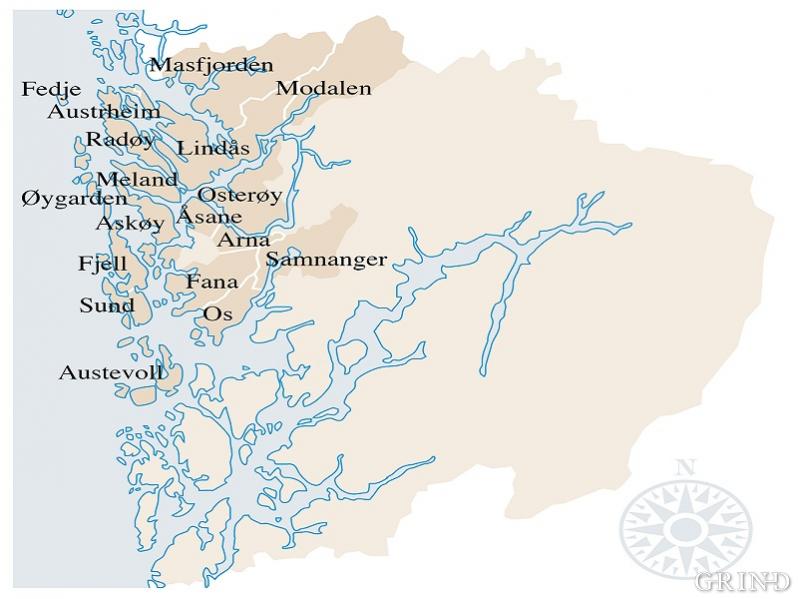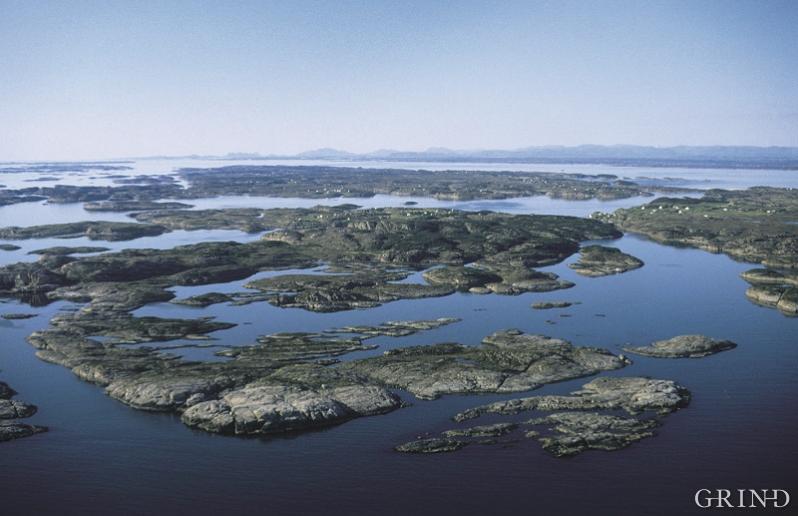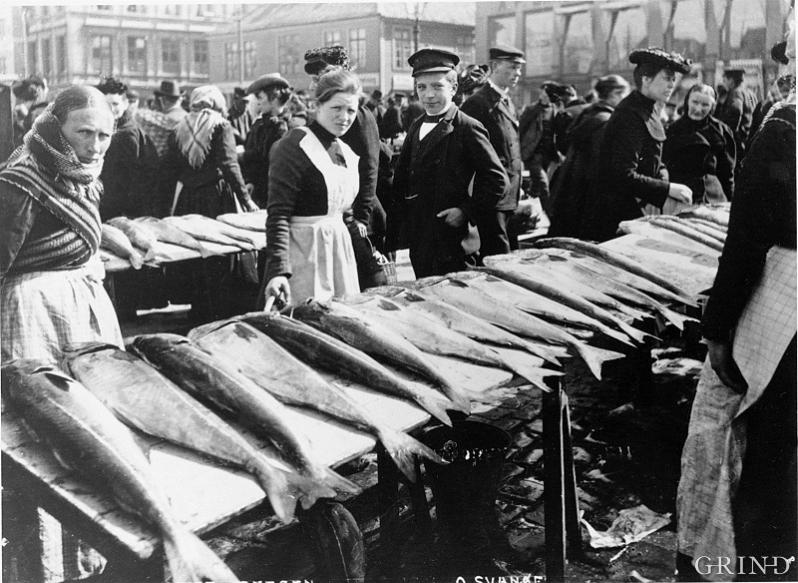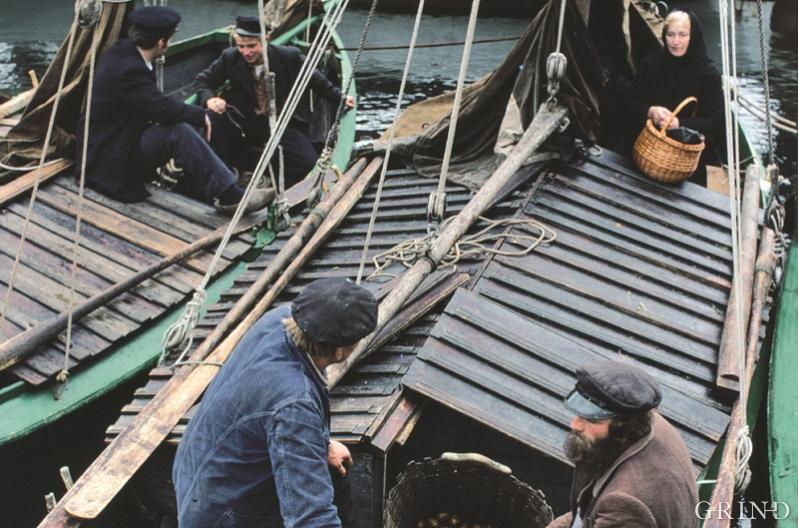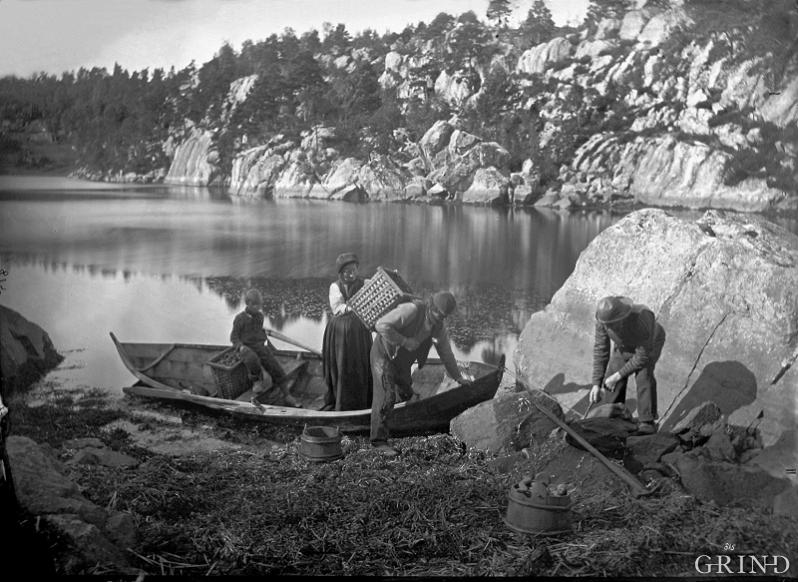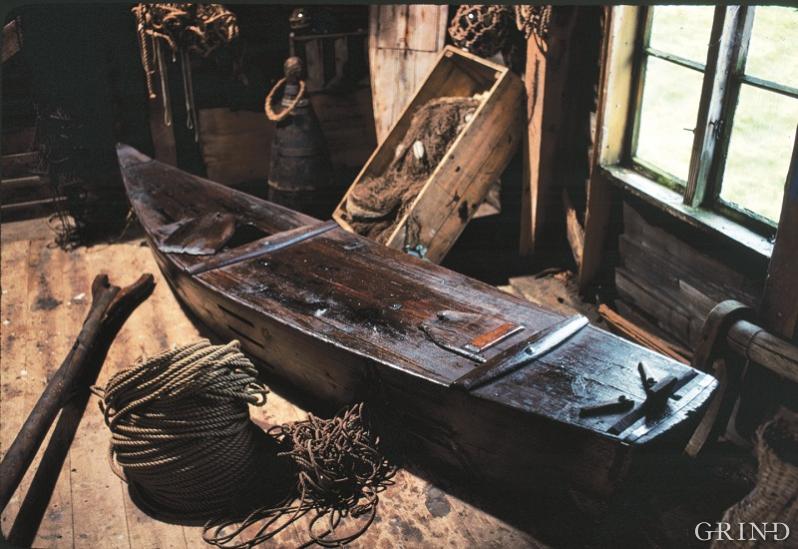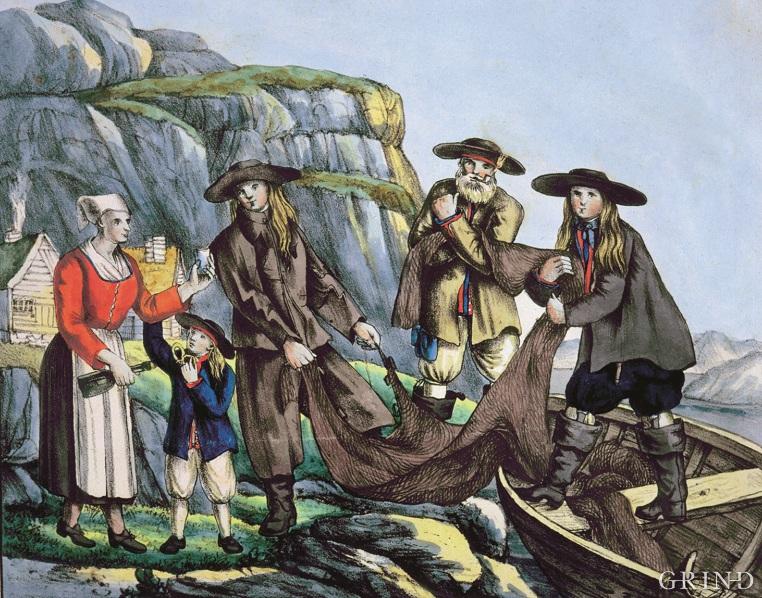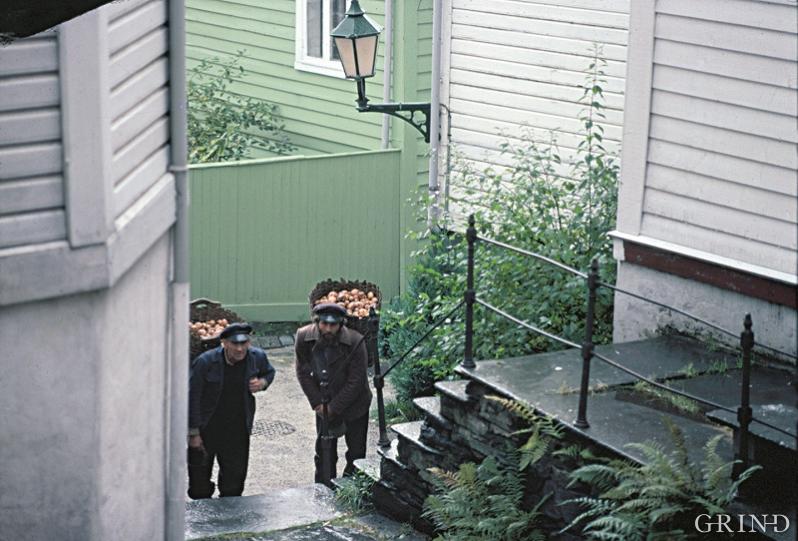Published: 19.05.2009 | Author: Anders Bjarne Fossen
“The triangle” at the Fish Market in Bergen about 1865: the classic meeting place between the Stril folk and the folk of Bergen. (photo: Knud Knudsen, owner: Picture collection, University Library in Bergen (KK 13, 13x18)) (section)
“The shore was choc-a-bloc with Saturday afternoon traffic. The country folk came in droves; halfway closing off the street, men and women with their arms round each other’s shoulders and wooden containers in their hands. They waddled forth with their short, stiff legs in their great sea boots, while the brown slush splashed up and to the sides and the reek of the country folk welled up amongst them. If anyone got in their way, they never made way and people had to look after themselves as well as they could. They bowled over women and small children who were not quick enough to leap out of the way and stepped over them unswervingly, without as much as dignifying the fallen with a glance. Latecomers from the Fana and Nattlands farmers trudged forwards, bent forwards, with buckets of cream in their hands, and on their backs, empty curdled milk containers; which reached from their necks right down to the tails of their white homespun sweaters … Servant girls with baskets on their arms, looking for warm bread for Sunday, when the bakers took a day of, stood in groups and shouted slogans and witticisms to their arch-enemies the country folk who, totally undisturbed, neither heard nor saw them.”
It is Amalie Skram who has given us this incomparable, contemporary portrait of an exciting cultural collision, in her collection of novels on the Hellmyrs people. The relationship between Bergen and its neighbouring districts, normally known as “Strilelandet”, has, over the centuries, given rise to greater conflicts than the contacts between any other Norwegian city and its nearest hinterland.
The country surrounding Bergen - "The grey realm"
Let us first make clear what we mean by the terms: “Stril country” and “Stril folk”. The meaning of the term “Stril country” is unclear to most people. That in itself is not strange. In fact the meaning of the term has always been shrouded in mystery and diffuse. Where the word “stril” comes from is equally unclear and there have been many explanations.
The first time we come upon the word “stril” in written sources is in 1723 in a brief piece by an unknown author from Osterøy. The piece tries to: “describe those persons in Bergenhus District and the Oster Fjord, resident Stril folk, their language, clothing, work, customs and ceremonies” . the author divides the inhabitants of the district into three groups as follows: “Wosser”, “Hardangere” and “Haarder”. “The Haarder people live in Nordhordlands judicial district of six parishes or more”, and these people, especially those who live on the Oster Fjord “are commonly called by everyone: “striler”” . Our unknown author thus limits “Strilelandet” to Nordhordland Judicial District.
Johan Sebastian Welhaven, a well known writer both in Bergen and its neighbouring districts is less precise in his definition. In his book: “Portraits from the Bergen District” (1842) he writes the following:
“There is a group of folk called “Striler”. They inhabit the part of Bergen County which is known as “Stril country”. This description is almost as uncertain as the term given to German tribes by Tacitus.; but it is also difficult to come any closer. There is something mysterious about the name: Stril. Sometimes it is taken to cover the whole of the west coast up to Stat, and sometimes it is limited to the country around Bergen; but in both cases it has a certain ring to it for the authors.… So we do not really know where the frontiers of this remarkable nation go. In Bergen people think that it is limited to Hordaland County”
So he actually puts forward three theories. “Stril country” is the whole of the West Norway district from Stad southwards, it takes in Bergen’s closest neighbours, or in the opinion of most folk in Bergen, it takes in the whole of Hordaland county or Southern Bergenhus county as the name was in Welhaven’s time.
There is now considerable agreement that it was this unknown inhabitant of Osterøy perhaps the wife of a civil servant, who, in her diary in 1723, came closest to the correct geographical definition. On the basis of a common economic background and cultural features it is reasonable to say that the Stril country takes in the districts around Bergen from Selbjørns Fjord and Bjørne Fjord in the south to the boundary with Sogn og Fjordane County in the north, and from the skerry guard in the west to Voss and Kvam municipalities in the east. These boundaries which roughly cover the old Nordhordland Judicial District should thus include the existing municipalities of: Austevoll, Sund, Fjell, Øygarden, Fedje, Askøy, Meland, Radøy, Austrheim, Lindås, Masfjorden, Modalen, Osterøy, Os and Samnanger as well as the previous municipalities of Åsane, Arna, Fana and Laksevåg which were incorporated into Bergen city in 1972.
Now the “Stril” people were not conceived of as a uniform group, but divided into two main groups based on geography. The up-country Stril folk (from the fjords, the “the kipestriler” ) lived to the east of the city and the Stril folk from the sea (the fishermen Stril) lived to the west of the city. The up-country Stril people were primarily agriculturalists while the sea Stril gained a living from what the sea provided. But all of them lived from agriculture and fishing. Between those two main groups - the up-country Stril people and the Sea Stril folk - there were differences in the way they lived, incomes and cultural expression. The up-country Stril people viewed themselves as being well above the Sea Stril folk, an impression that most city people from Bergen shared, whether it was the ordinary citizen or the city’s administration.
Just as obscure as the boundaries of the Stril country, are the origins of the name “Stril”. One theory leads back to Håkon Håkonsson’s Saga where Steingrim Stryl is mentioned, and who gave Håkon his king’s name in Bjørgvin. Another theory takes it from an old Norse word which means “grey” or “glossy” and reflects the naked, weather beaten areas which make up such a large part of the Stril country - the grey realm - as it was called then.
The economic basis
To find an explanation for the poverty which placed the Stril country in a special position within the districts of Norway, we must look to natural conditions and the economic basis. The fishing Stril folk from Sund to Fedje found themselves in an unfavourable position despite their proximity to the sea. Local fishing took place throughout the year, often in the nearest inlet or fjord. This meant that they always had something to eat and that they had a little fish for sale. But the fisheries that was to give everything else that a family needed, in the first instance, seasonal fishing for herring, took place far from the coast of the Stril country. This was true particularly for the most important fisheries, the spring herring fishery, the “northern fisheries” on a stretch of coast from Sunnfjord to Nordfjord. From the end of February onwards this was replaced by the “southern fisheries” in the areas around Karmøy.
Both of the fisheries were enormously rich, from when the infiltration of the herring began seriously in 1808. The Stril folk were situated about halfway between them, and if they wanted to take part in both they had to equip themselves for a 10 week trip each year to the areas which extended from Kalvåg north west of Florø to Skudeneshavn on the southernmost tip of Karmøy. Equipping was expensive; one needed bigger vessels than the usual rowing boats for four or six oars. The net boat alone cost about 30 speciedaler. Nets, food and clothes required a further 30-40 dalers. And then there were also some more dalers needed for accommodation during the fishing itself.
For fishermen who lived nearer the fishing grounds than the Sea Stril folk, the situation was different. They could usually fish from small boats, and in every way, could get by with more reasonable equipment. As the Bergen traders’ privileged position within fish processing and trading in fish became weaker, a series of salting plants were also established along the coast where the fisheries took place, at the same time as the herring was increasingly exported in fast launches which the country folk owned themselves. The fishing population in the north and south could benefit from the welfare that the fisheries could provide in a completely different way than in the Stril country’s coastal areas. Fishing was also important enough for the Sea Stril folk, but it gave them much less of a profit than those who were their neighbours along the coast of West Norway.
So when the fisheries failed, the Sea Stril people had only their crofts to fall back on and these were not up to much. . In 1863 the county agronomist claimed that the Sea Stril folk regarded working on the farm and with fertiliser as a “misdeed”. Even in the best agricultural villages in the Stril country working methods were primitive and, compared with other places in the country. The fields were cultivated with a wooden spade - “the stril spade” as it was called - and with a hoe and a rake. In the middle of the 1850s the county administrator claimed that there was a widespread belief amongst the Stril folk that “The plough and the harrow ruin the land”. This conservatism as regards equipment was due to several factors. The patches of field were small and were spread out between the piles of stones. The soil was only 6 to 12 inches deep and when it was also sloping, it was not suited to the plough or the harrow. Nor was the system of strip farming conducive to the use of new equipment and better working methods.
For the Stril country as a whole the basis for subsistence was not improved with the rapid growth of the population. More and more people had to share whatever a static agriculture and an uncertain fishery could provide. Between 1769 and 1865 the population in Søndre Bergenshus county grew by 106%. In Sunnhordland judicial District the increase was only 68% - in the Stril country it was as much as 143%.
In order to survive the Stril people had to find additional ways of making a living, not to speak of netting and seine production, which became an entire cottage industry for women and children in Manger from the beginning of the 19th century. Making fishing nets as payment for goods from the Bergen merchants on the Stril country, which Eilert Sundt tells of, placed people in a position of economic dependence on the agricultural traders of Bergen, a special type of cottage industry where city retail merchants advanced money against labour contributions. But however hard the Stril folk worked, and however resourceful he proved to be in providing extra incomes, his living was meagre - and uncertain.
Bergen, "the renowned Norwegian trading city”
The Stril country’s closest neighbour was the rich and powerful Bergen City. Bergen became, in a completely different way from other Norwegian cities, a cosmopolitan city, an international trading centre, known by traders and seafarers in distant centres such as Novgorod, Smyrna and Lisbon. In this city you could meet retailer citizens born in Danzig, Hamburg; Bremen, Hannover and other German cities. Here you could come across sea captains whose cradle had stood in the world’s greatest seaports such as London and Amsterdam, or meet tailors from St.Petersburg, goldsmiths from Breslau, pearl embroiderers from Dresden and weavers from the Faeroes Islands.
This inflow of people with their roots in other countries not only contributed to expanding Bergen’s central role in Norwegian business, but also ensured that the town became the country’s most important entry point for the cultural and political currents which had taken root out in Europe. We can observe this influence in the language of Bergen; in the hotchpotch of impulses which gradually created the so-called Bergen style within architecture, in the people’s habits of dressing and in the decoration of their homes, and even in the children’s toys and games, in nooks and crannies of the old city. (locally known as smitt and smau).
Even although, economically speaking, Bergen had many legs to stand on, it was nonetheless trade which dominated. The most important export item was dried fish, but also stockfish, salted fish, cod liver oil, fish roe and herring were significant. Where did these goods come from? Dried fish, cod liver oil and fish roe came primarily from north Norway; from Lofoten, Vesterålen, Finnmark and Sunnmøre. When the spring herring fisheries got started seriously in 1808 and last with some minor breaks up until 1870, it was the districts from Florø to Sognesjøen and from Bomlø to the most southerly point on Karmøy which provided herring to the shopkeepers of Bergen. The stockfish came almost without interruption from Sunnmøre and Sjølenene; the old name for Romsdal, Nordmøre, Fosen and Namdalen. Bergen exported a great deal of timber for a long period. This came in the most part from Sunnhordland, Sogn, Nordfjord and Sjølenene. In the same way leather goods came from Sogn, Sunnfjord, Nordfjord and Sunnmøre. But none of this came from the Stril country.
What does this all mean? It means that none of the goods which established Bergen’s reputation as Norway’s great trading centre, came from the city’s nearby hinterland. Bergen’s welfare depended on whether it was a good or a bad year for the fisheries - in the first instance in North Norway. The Bergen merchants did not look forward with any degree of excitement to what cargoes the Stril people’s rowboats and small boats carried on their frequent trips to the city, but they did spy northwards with eager glances at the time around 17th May from their look-out posts on Nordnes, so as to catch the first glimpse of the square rigged Nordland sloops when they came into view in their numbers at Askeneset. In practice it was Nordland and Finnmark Counties which became Bergen’s most important hinterlands , whilst the strilelandet, its geographically natural hinterland, was outside the economic area of interest of Bergen’s foreign traders. The inhabitant of the Stril country was for him an indifferent and insignificant person.
So we experience the paradoxical situation whereby it is the most distant areas in the north of Norway which mean most for Bergen’s existence, to a lesser extent Sunnmøre, to an even lesser degree Nordfjord, Sunnfjord and Sogn and to the very least the Stril country just on the city’s doorstep. This was a unique situation for a Norwegian city. All our other market towns had, in a completely different way, business interests in its nearest hinterland which supplied considerable volumes of goods which the towns needed for their export trade. The Bergen merchant, crafts producer, sea captain and not least the public servant were economically, culturally and socially superior to the stril person; the great majority of the town residents, apprentices, ordinary seamen, ferrymen, haulers, harbour workers and servants - all of them felt superior to him.
Stril folk and Bergen folk
However we must, by no means, be under the impression that the Stril country’s inability to provide the city with export goods meant that there was no contact between the city and the rural areas. In fact the situation was quite the reverse and there was a close connection, but on another level. The people of the Stril country were completely dependent on a supply of corn from the city, and as far as the people of Bergen’s needs for day-to-day goods it was Stril country which provided them. The people of the Stril country supplied milk, butter, meat, vegetables and not least herring and other fish. From the Haus areas, the Arna district and the Samnanger area came the farmers with their goods in wooden baskets on their backs or in saddle bags up Langedalen and then on foot over Borgeskaret, through Hardbakkedalen and then on to the horse track down Isdalen - or they went through Heldalen over Natland to Haukeland. Here they met up with the farmers from Fana and Os and together headed for the city. When they got there they visited their regular customers in the narrow back streets - or made for the Market Place to sell their goods there.
Nonetheless most of the goods from the Stril country came by sea to the city. And it was especially on the main market days of Wednesdays and Saturdays that there were rowing boats everywhere towing along fish boxes. The great majority of these were towed into the Market Place between ships from many nations and sloops and small vessels from the small harbours between Egersund and Troms , as well as hundreds of Nordland sloops when one of the three annual Nordland Fairs - Nordfars Fair - was in progress. During the fair times there was usually only a narrow channel of open water through to the Market Place. The Stril people had to come right in here with their fish, according to city bye-laws, and they were sold directly from the rowing boats until sales were transferred to over the counter in the market Place itself under a regulation introduced in 1911. However many boats did not go right into the Market Place, but found their way to one of the regular farm traders, or they moored beside the common land between the parish barges from Sogn fully loaded with firewood, to transport farm goods which were then taken to regular customers at home.
For the Stril folk the weekly trip to Bergen - which they called “Red Top” because of the red tile roofs - was a dubious privilege that they would rather have foregone. Bargaining with the city’s housewives, madams and not least servant girls was an ordeal where the snappy Bergen responses were seldom interrupted by the Stril folk’s slow, sober assurances regarding the fish’s quality, and that justified the prices they demanded, as we know from Amalie Skram’s striking portrait in Hellemyrsfolket
Despite the often unpleasant encounters with the city, there were not a few Stril folk who saw the possibilities of a materially better life in the city. Some of them settled down as hucksters or practitioners of simple trades, but most of them ended up in jobs which ranked as the lowest in the city, both as regards income and social position. The men made a living as labourers, ferrymen, haulers coachmen and stevedores. The women became washerwomen, knitters, spinners, market women - and not least servant girls. It is perhaps not so strange that it was precisely many of the city’s servant girls, originating from the Stril country, that distanced themselves from their past, by becoming the Stril country’s arch-enemies.
The city and the stril country grow up together
Today the Stril country has come a long way to conquering Bergen. But at the same time we can talk of the city slowly conquering the Stril country. It started towards the end of the 18th century, with the construction of big, beautiful, manor houses in the neighbouring districts in which the city’s grand folk and public servants spent the summer months.
We do not have any exact figures for the migration to Bergen before 1920. Of the total population of 91,000 in that year 38% were born outside the city boundaries. 13% or 11,500 were born in the Stril country. The Stril folk thus constituted the biggest group of immigrants in the city. Only 2% were born in Sunnhordland and 1% in Hardanger and Voss. Bergen, which in 1735 had 12,000 inhabitants would have only had 3,000 to 4,000 inhabitants had it not been for the big surplus of immigrants In fact the population in 1801 was 18,100. If we go forwards to 1967-1968 we find that 25% of all of those who had moved to Bergen came from the Stril country - from areas within a radius of 50 kilometres from the Fish Market. It is interesting to note that migration from neighbouring areas is very much less in other cities.
In this development, increasing parts of the Stril country became a part of Bergen.: Strandviken from Mulelven to Jelleneset in 1877, the whole of Årstad parish in 1915, Gyldenpris (annexed from Laksevåg) in 1921, Fyllingsdalen in 1955, and then the big city expansion in 1972 when Åsane, Fana, Laksevåg, and Arna were incorporated into the city.
The Stril country’s gradual conquering of the city and the Bergen folk’s corresponding conquering of the Stril country have erased many of the old divisions between the city and the rural districts. Confrontation has been replaced by cooperation. The expression “stril” - once an exceptionally derogatory characteristic, frequently used in jolly parties in Bergen, contemptuously cast after farmers and fishermen on their journeys through the city streets, or used as an argument in buying fish at the Market Place, is today largely regarded as a neutral characteristic on the same level as “citizen of Trondheim”, “citizen of Sogn” or “citizen of Bergen”. Although not quite. The economic, social and cultural gap between the neighbours here in the west has been too deep and lasted too long.
- Garatun-Tjeldstø, G. (1976) Strilen: det "mærkværdige Folk". Hartvedt, G. H. red. Hordaland og Bergen. Bygd og by i Norge. Oslo, Gyldendal, s. 31-58.
- Rafto, T. T. (1953) Bergen og omland 1840-70: et omskifte. I: Skrifter (Bergens historiske forening). Bergen, Bergens historiske forening, nr. 59, s. 5-263.
- Revheim, J. (1953-54) Nordhordlendinger på bygningsarbeid i Bergen: ei innføring. Land og hav. Bergen, Hordaland landbruksmuseum, s. 145-164.
- Solheim, T. (1978) Ei strilekrønike. Oslo, Samlaget.


